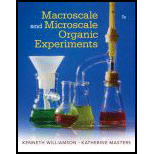
Macroscale and Microscale Organic Experiments
7th Edition
ISBN: 9781305577190
Author: Kenneth L. Williamson, Katherine M. Masters
Publisher: Brooks Cole
expand_more
expand_more
format_list_bulleted
Question
Chapter 3, Problem 10Q
Interpretation Introduction
Interpretation:
The reason for the slow and steady heat up of the melting point bath near the melting point should be determined.
Concept introduction:
Temperature at which an element changes from the solid state to the liquid state is known as melting point or sometimes liquefaction point. At the melting point, both solid and liquid phase coexist in equilibrium. It depends on the pressure and is normally defined at the standard pressure
Expert Solution & Answer
Trending nowThis is a popular solution!

Students have asked these similar questions
. When checking the melting point of your impure sample, what temperature should you set as thestarting temperature (the SET temperature) and what should the ramp rate be?
Briefly explain why it is important to use crucible tongs when you transfer the heated crucible
(a) from the clay triangle to the heat-resistant mat
Describe the process inside the test tube during boiling point determination (In other words, why not take the boiling point when the first bubble comes out but rather when the last bubble comes out?)
Chapter 3 Solutions
Macroscale and Microscale Organic Experiments
Knowledge Booster
Similar questions
- BRIEFLY explain why steam distillation can be used to purify or isolate temperature-sensitive materials.arrow_forwardHow does the ramp rate affect the actual AND observed melting point?arrow_forward10. Which is a way to induce crystal growth if no crystals are forming upon a. scratch air-liquid interface on flask with a glass rod or spatula b. add a seed crystal c. boil off excess solvent volume d. all options are possibilitesarrow_forward
- A student placed about 1 cm of freshly recrystallized loosely packed solid into a melting-point capillary tube. The student noted that the solid melted 30 degrees lower than expected and the solid seemed to jump/separate in the tube as the temperature increased in the melting point apparatus. When the student measured the melting point the following day with less solid that was more tightly packed, the melting point was at the literature value. Explain what all went wrong with the student's first samplearrow_forwardTrue or False. It is very important to regulate the temperature of the heating mantle so that the distillation occurs at a rate of about 1 drop per 2 seconds. Explain why?arrow_forwardWhen checking the melting point of your impure sample, what temperature should you set as the starting temperature (the SET temperature) and what should the ramp rate be? For example, if the sample is believed to melt at 70°C, at what temperature should you begin to heat the sample?arrow_forward
- 1. What is the limitation of the sublimation laboratory technique? 2. When can sublination be applied as a process of separation?arrow_forwardWhy is it important to cool slowly during recrystallizationarrow_forwardDraw the chemical structures of two bonded nonpolar phases and two bonded polar phases in HPLC. Begin with a silicon atom at the surface of a silica particle.arrow_forward
arrow_back_ios
arrow_forward_ios
Recommended textbooks for you
 Macroscale and Microscale Organic ExperimentsChemistryISBN:9781305577190Author:Kenneth L. Williamson, Katherine M. MastersPublisher:Brooks Cole
Macroscale and Microscale Organic ExperimentsChemistryISBN:9781305577190Author:Kenneth L. Williamson, Katherine M. MastersPublisher:Brooks Cole EBK A SMALL SCALE APPROACH TO ORGANIC LChemistryISBN:9781305446021Author:LampmanPublisher:CENGAGE LEARNING - CONSIGNMENT
EBK A SMALL SCALE APPROACH TO ORGANIC LChemistryISBN:9781305446021Author:LampmanPublisher:CENGAGE LEARNING - CONSIGNMENT

Macroscale and Microscale Organic Experiments
Chemistry
ISBN:9781305577190
Author:Kenneth L. Williamson, Katherine M. Masters
Publisher:Brooks Cole

EBK A SMALL SCALE APPROACH TO ORGANIC L
Chemistry
ISBN:9781305446021
Author:Lampman
Publisher:CENGAGE LEARNING - CONSIGNMENT